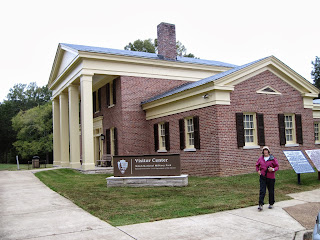We walked along the Sunken road, its not really sunken, and stopped at each monument. Here were stones placed to commemorate each of the Iowa regiments that held at a place called the Hornets Nest against attack after attack. One of them, the 12th Iowa, had even had to about face and repel an attack from the rear. They eventually were surrounded and had to surrender, but the dying hadn't stopped. Seventy one of the men died in a Confederate prison.
It wasn't just Iowa regiments that held here, Missouri, Michigan, Indiana, Wisconsin, Kentucky, and Ohio markers were all represented. The survivors, (over two thousand were surrounded and captured), finally retreated to Grants final line but they had held long enough. Johnston's final attack failed and Grant attacked and won the battle the next day.
Shiloh was the last on my list of Civil War Battlefields and in preparation I had bought the battlefield guide, Shiloh. Its over one hundred and seventy pages long and so I read it in advance and thought I was ready to guide us in our drive from stop to stop.
However it wasn't like Gettysburg or Antietam and we quickly became confused due to the thick forest. It made us understand the confusion that the undergrowth and rugged terrain had caused in the rebel lines. Finally figuring it out, we found where the battle had started and were able to trace the sequence of events.
Pausing at the Confederate monument I simply could not comprehend the bravery showed by the soldiers on each side.
Bloody pond was next to the sunken road, and we watched fish swim lazily in the shallow sunlit water. The myth said the pond was named for all the blood from the wounded and dead that stained its color but its another of those myths that surround this place.
A cannon stood where each general was killed, and it wasn't really surprising how close Lew
Wallace's and Sidney Johnston's monuments were to one another. Each step we took was on sacred ground and we both were silent in our thoughts. I had no relatives that had fought here, mine had passed at the siege of Vicksburg, and not from battle wounds but from mosquito borne sickness, (their Iowa regiment of sharpshooters had been place in a swamp).
Our last stop was where the final Confederate attack failed as the men had to cross a creek and climb a steep hill. During all that time they were bombarded by Union gunboats, shot at from the final line and further bombarded by Union batteries.
The park headquarters here has a hour long movie that we both highly recommend should you ever visit here. The battle field guide we used was simply too much to properly use in the time we had, (the book says six hours is required to visit the sites but we used most of a day for the first day of the battle). I wish everyone could walk this and other such places to realize how special our country is and the heavy price paid. Perhaps then they wouldn't sign fools petitions demanding succession.
Clear skies.







Good post - did you ever read the book Andersonville? - C
ReplyDelete